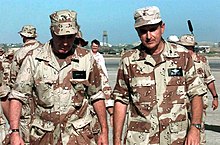Operation Restore Hope
Operation Restore Hope ( English for Operation Restoration of Hope ) was a United Nations- backed US military operation in Somalia in 1992/93. The official goal was to provide humanitarian aid to the victims of civil war and famine , as well as to restore public order and to set up a central government for Somalia.
history
In view of the difficulties of the UN mission UNOSOM , which had existed since April 1992 , the USA offered to send a multinational UNITAF force under its own leadership to provide support. The United Nations Security Council approved the deployment of UNITAF with resolution 794 of December 3, 1992 and made UNOSOM operations subordinate to it. On December 9th, the first UNITAF troops including the I. Marine Expeditionary Force from the USA went ashore on the Somali coast. The command was Lieutenant General Robert B. Johnston. Around 1,300 Marines landed by helicopter at Mogadishu Airport on December 9th . The "Task Force Mountain" as the US American part of UNITAF consisted of parts of the 2nd Brigade of the 10th US Mountain Division and around 10,000 soldiers. Commanded by Brigadier General Lawson William Magruder III, from December 22, 1992 by Maj. Gen. Steven L. Arnold.
On December 28, 1992, the Task Force TF 2-87 shifted consisting of a US infantry battalion and the 1st Canadian Airborne Battle Group from Mogadishu to Beledweyne (Belet Uen). Another Task Force TF 3-14, consisting of another US infantry battalion, was flown directly from the USA to Somalia and stationed in the Kismayo region. In addition, an element of the United States Special Operations Command Central consisting of five “Operational Detachment A (ODA) teams” of the 5th Special Forces Group (Airborne) for psychological warfare was stationed in Mogadishu, whose headquarters were called Joint Special Operations Forces-Somalia (JSOFOR ) was designated. On January 1, 1993, US President George HW Bush ended his visit to Somalia. On his trip he visited the famine-stricken city of Baidoa , the capital Mogadishu and the US troops stationed at the Balidogle military airfield in the south of the country. He then returned to the offshore amphibious warship USS Tripoli (LPH-10). The next day, Bush traveled to Moscow to sign the START II disarmament treaty .
However, UNOSOM / UNITAF was fought by various Somali warlords, namely Mohammed Farah Aidid . Parts of the Somali population - as well as some Western observers - also attributed less noble motives to the USA, such as gaining control over oil stocks or the permanent establishment of military bases in the strategically important Horn of Africa . Since the USA also specifically turned against Aidid in the course of the operation, it, and with it the entire UNOSOM, lost its neutrality and was increasingly involved in fighting with Somali militias.
The end of Operation Restore Hope is often given on March 3, 1993, when the mandate of UNOSOM / UNITAF was transferred to UNOSOM II . The USA referred to the follow-up operation as part of UNOSOM II as "Operation Continue Hope". After in the " Battle of Mogadishu " on 3./4. October 1993 18 US soldiers had been killed, the US withdrew its troops from Somalia by the end of March 1994.
See also
Web links
- George Monbiot on the Operation Restore Hope (English)
- Nils Goede: The Intervention of the United Nations in Somalia. An analysis of the decision-making processes in the Security Council for Resolution 794 . (PDF; 821 kB) INEF report No. 98, 2009 Duisburg.


